ISSN ONLINE(2319-8753)PRINT(2347-6710)
ISSN ONLINE(2319-8753)PRINT(2347-6710)
KOUASSI Kouadio Henri1, KOUASSI Roland Hervé2, KOUASSI N’dri Jacob1 and N’GUESSAN Koffi3
|
| Related article at Pubmed, Scholar Google |
Visit for more related articles at International Journal of Innovative Research in Science, Engineering and Technology
The identification and the evaluation of the impact on the flora and the environment of Adaou, a locality near Aboisso a town, situated in the South of Côte d’Ivoire is a capital phase which intervenes following the realization of the project of the establishment of a factory of a thermal center in order to put forward measures of attenuations and/or corrective. This report highlights and evaluates the positive and negative impacts of the project on the flora of the site. This study is based on floristic inventories inspired of the itinerant method combined with the method of the small squares. The objective was to identify and evaluate the subsequent impacts with the realization of the project in order to prevent the ecological risks of imbalances, which could reappear in the zone. The data collected showed that the flora is rich approximately 95 species. It comprises in addition, the proposals of corrective measures and/or an attenuation of possible eco-climatic imbalances related to the establishment of this factory. It must moreover be used as a basis of data for the orientation of work to carry out and in decision takings.
Keywords |
| influence, establishment, thermal center, electricity, flora, Aboisso |
INTRODUCTION |
| The Biodiversity must be preserved for the survival of planet. The survival of very whole humanity depends on it. Indeed, the unit fauna-flora is an essential link which takes part to a significant degree in balance of the ecological systems. Unfortunately, over the years this unit pays the full price of human frenzy for needs for all kinds. Among the forms of recorded use and/or aggression within the ecosystems of the tropical zones, agriculture, the exploitation of the forest products (sawlog, products secondary), the poaching, wars etc. appear in pole position of the factors of massive destruction of the unit fauna-flora. Thus, the surface of the vegetable formations of the tropical worlds knew a fulgurating regression since the beginning of the 21st century. This regression affects the quality and the quantity of the flora and fauna; in particular the specific diversity. The surface of the vestiges of forests of Côte d'Ivoire is currently estimated at less than 2 million hectare, whereas it was estimated at more than 15 million hectares at the beginning of independence (Kouassi, [1]). Face to this permanent destruction of the ecosystems, the concerned international organizations of the survival of humanity recommends the security measures of kind to guarantee and support the life in all its forms in the ecological mediums. Because actually what the human being inflicts to the nature, it inflicts it to himself. One of the recommended security measures is the identification, the evaluation and the characterization of the environmental impacts. Indeed, the knowledge of the characteristics of the flora (composition, specific diversity, specific wealth, ecological diversity and biology) and their evolutions under the effect of the natural factors are a precondition to any planning of search for measurements and attenuations of negative impacts on the flora of a locality (Kouassi et a., [2]). The present study aims to characterize the impacts of the project of establishment of a thermal center on the flora of the locality of Adaou. It was carried out in order to put forward measures of attenuation and/or corrective to prevent the risks of ecological imbalance which could occur in the zone. |
RLATIVES WORKS |
| Many works of environmental impact evaluation were completed in several ecosystems to prevent in time the risks of ecological imbalances. These works are those of Kouassi et al. (2013) bearing on the impact of the iron ore extraction in the mountains in the west of Côte d'Ivoire, and those of Kouassi et al. [3] and Kouassi et al. [4], relating respectively to the influence of the creation of a banana serves plantation in the north of Côte d'Ivoire and the, impact of the Construction of a Warehouse of plant health products on the flora of the site of city In the South-West of the Côte d'Ivoire. Similar works are nowadays carried out everywhere in Africa and in the world in order to identify, to evaluate and put forward measures of environmental impact attenuation. |
EXPERIMENTAL WORK |
| The site of the factory of the thermal center of and production of electrical energy (Fig. 1), belongs to the ombrophilous sector of the Guinean field. This sector is dominated by an ombrophilous forest with the presence of hydromorphic formations. The ombrophilous forest is made of three principal layers (Guillaumet and Adjanohoun [5]): the low or herbaceous layer is not very important; the average or shrubby layer reaching 20 to 30 m height. This luxuriant vegetation in the past gives way today to the degraded forest and fallow (without culture) which shelter that and there some forest small islands and a curtain of gallery forest. The flora of the site and those of the contiguous ecosystems (zone cultivated, forest river) were inventoried. This wide forest is threatened in Côte d'Ivoire, since it comprises several exploited species (Aubréville, 1957 [6]). |
3-1- Floristic inventory |
| Two methods were combined to conduct this study: the itinerant inventory of the flora by the enumeration of the species on layouts and the method of the small squares (Gautier et al., [7]) which consists in describing the vegetation (enumeration and classification of the species) on plots of approximately 20 m on side according to the four cardinal points and a spacing precise. Thus, 6 plots of 20 m side each one were delimited with the hectare in each inventoried vegetable formation (Fig. 2). These plots were distant each other from at least 50 m. Two aspects of the vegetation were approached. IT was specific diversity and the typology of the ecosystems. |
3-2 Flora analyzes |
 |
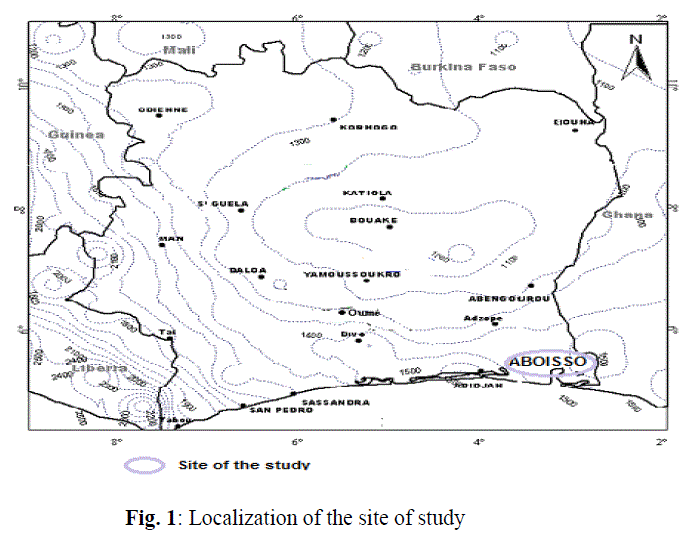 |
| - Plots of the flora inventories |
RESULTS AND DISCUSSION |
4-1-Results |
| The forest of the site formerly rich and diversified is replaced today by a sparse agrarian landscape comprising plots of cultures of revenues (Hevea, Palm tree), fallow dominated by Chromolaena odorata, humid middle, a large pit covered by plants (Fig. 3) and food plots (Fig.4). Also, in spite of the presence of enclaves preserved in the form of classified forests (Soumié, Ehania and Kotoagina), the important remaining surfaces of vestiges were already seriously started. |
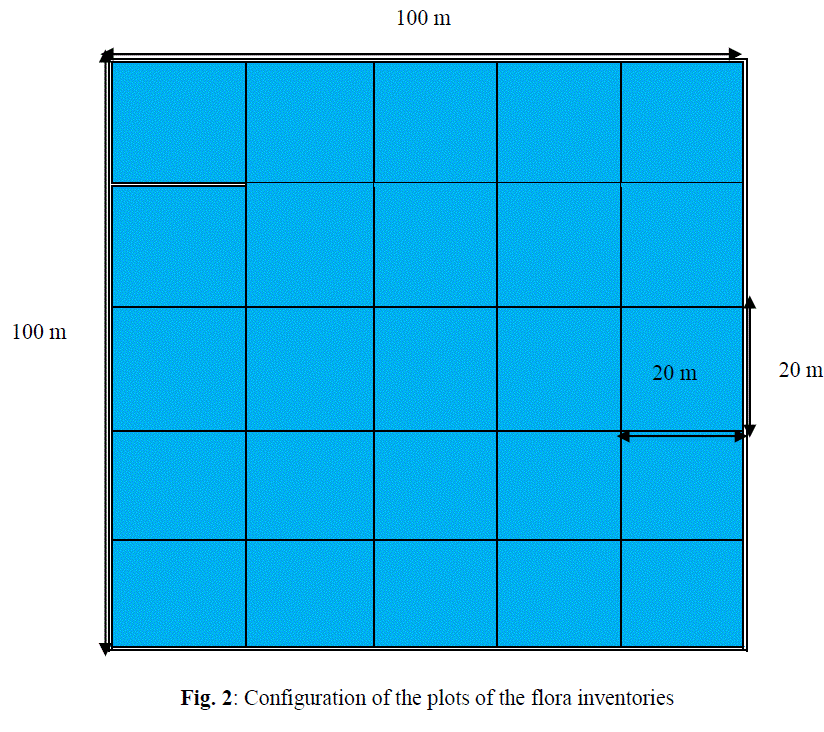 |
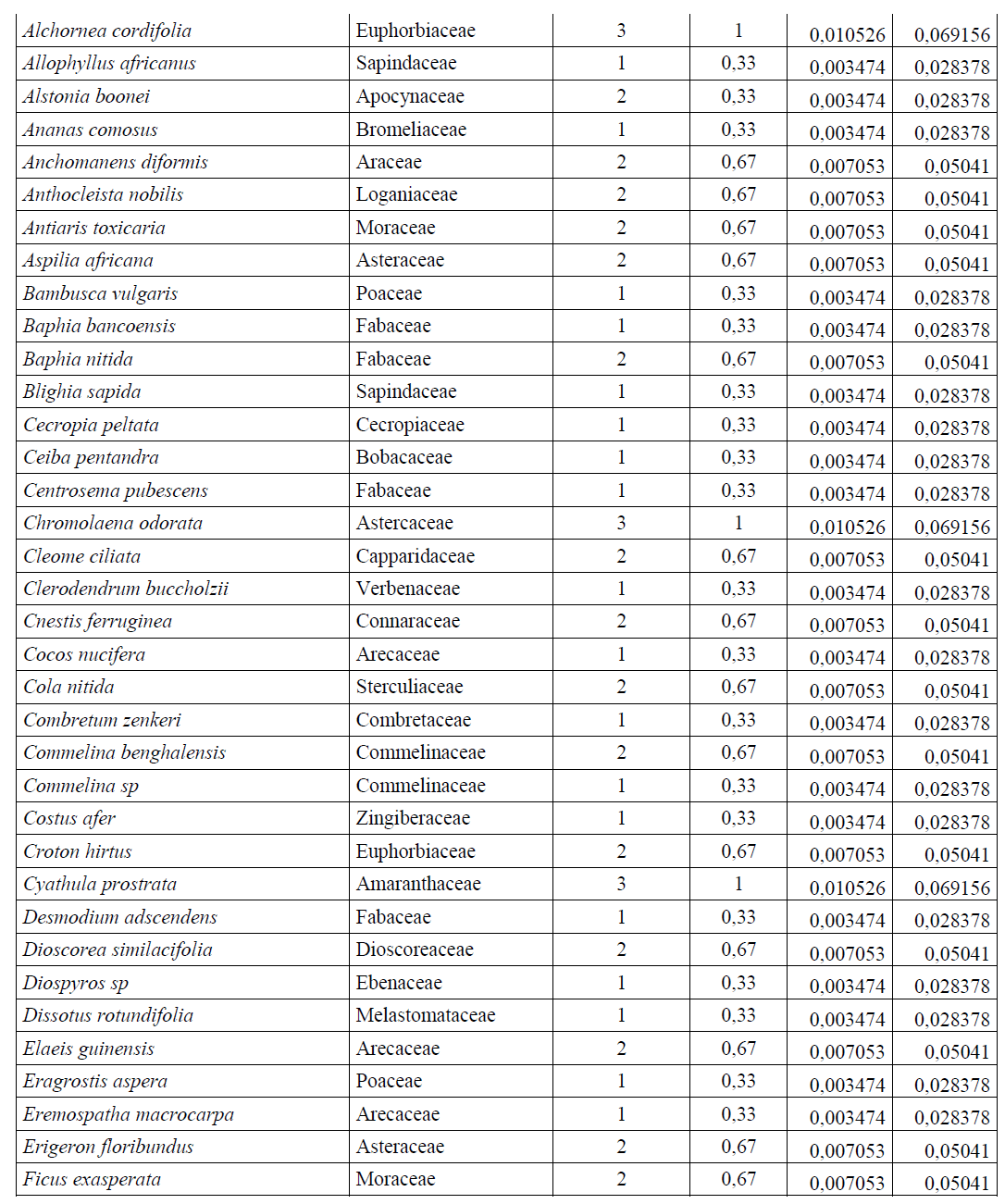 |
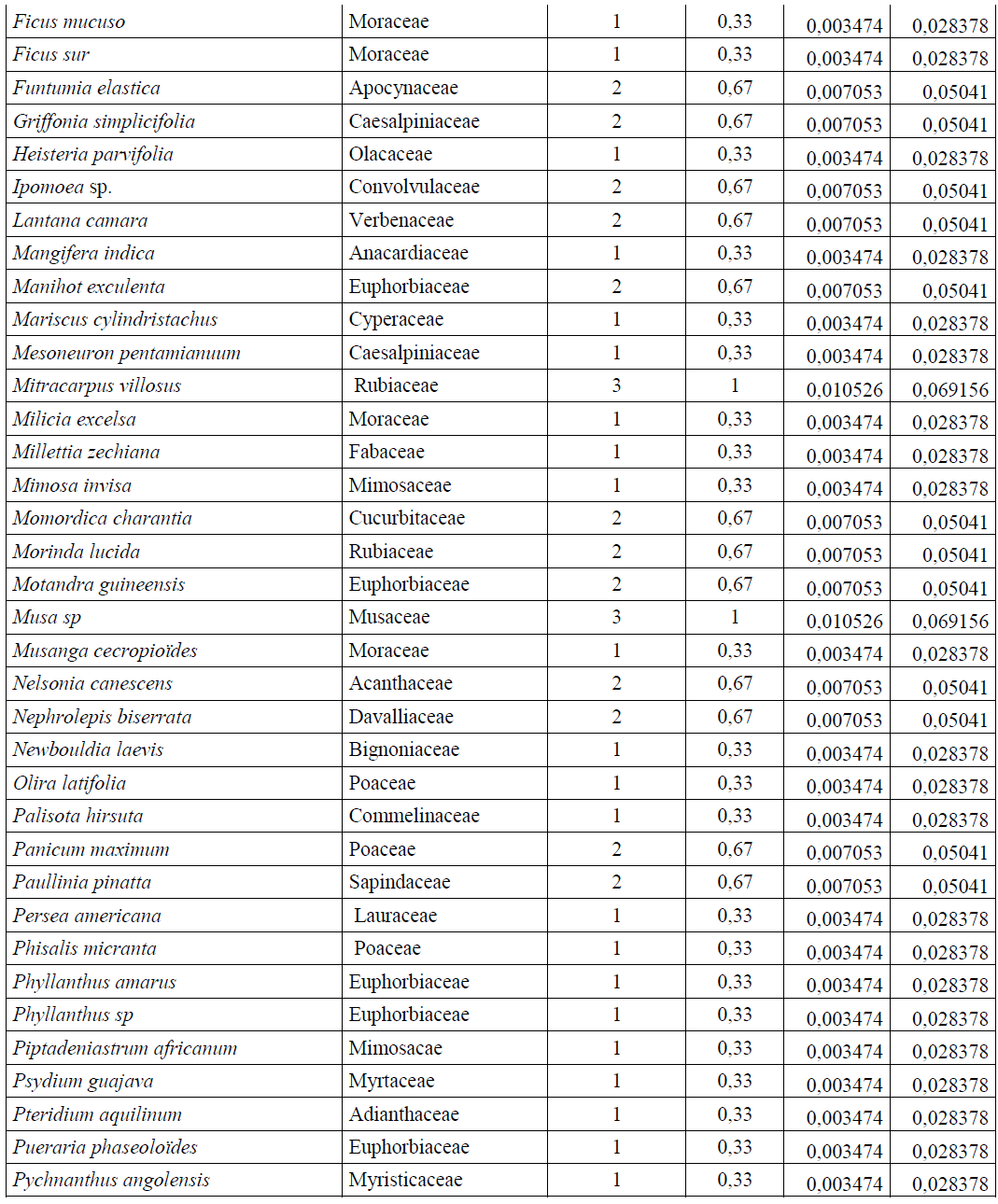 |
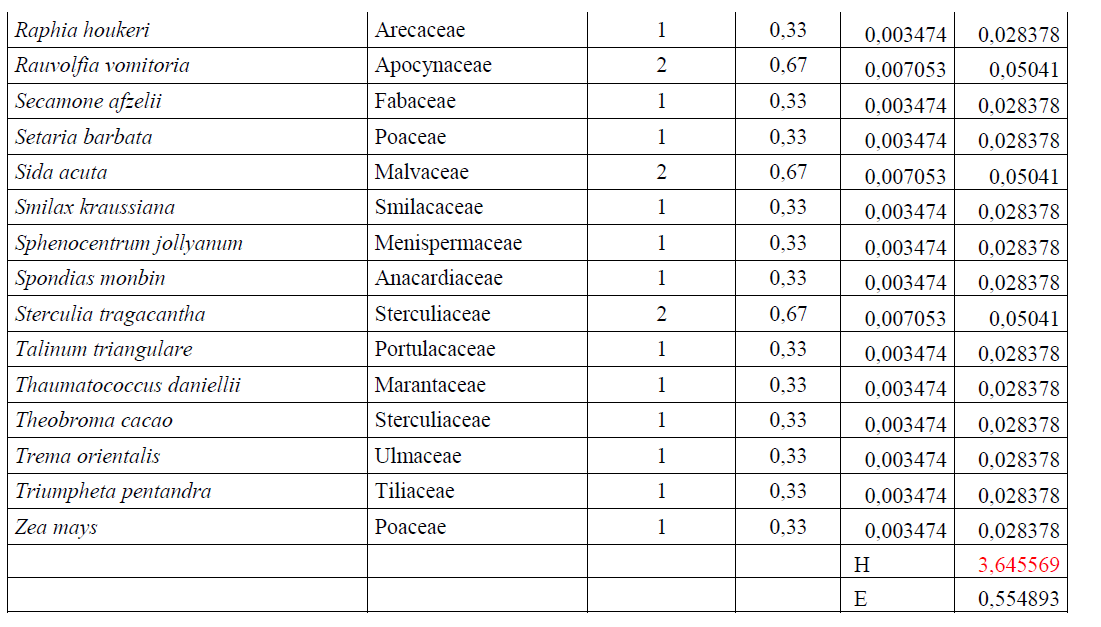 |
4-1-2- Identification, evaluations and characterization of the impacts |
| The data analysis collected during investigations has in obviousness, the various impacts of the realization of the project on the floristic communities. Thus, with the phase of construction, the evolution of the curves (Fig. 5) shows the variation of the impacts on the vegetation, the flora of the site and on that of the contiguous vegetable formations. During this phase, the destruction of the plant species (DEV.) was intense (3), fairly wide (2), of short time (1) and fairly important (2). The destruction of the potential of regeneration was intense (3), with average extended (2), an average time (2) and importance (3). Whereas, the deforestations (DEB) have summer of low intensity (1), with average extended (2), average duration (2) and very important (3). The ecological disturbances (EP) caused by the activities were fairly intense (2), fairly extended (2), average important (2) and average duration (2). |
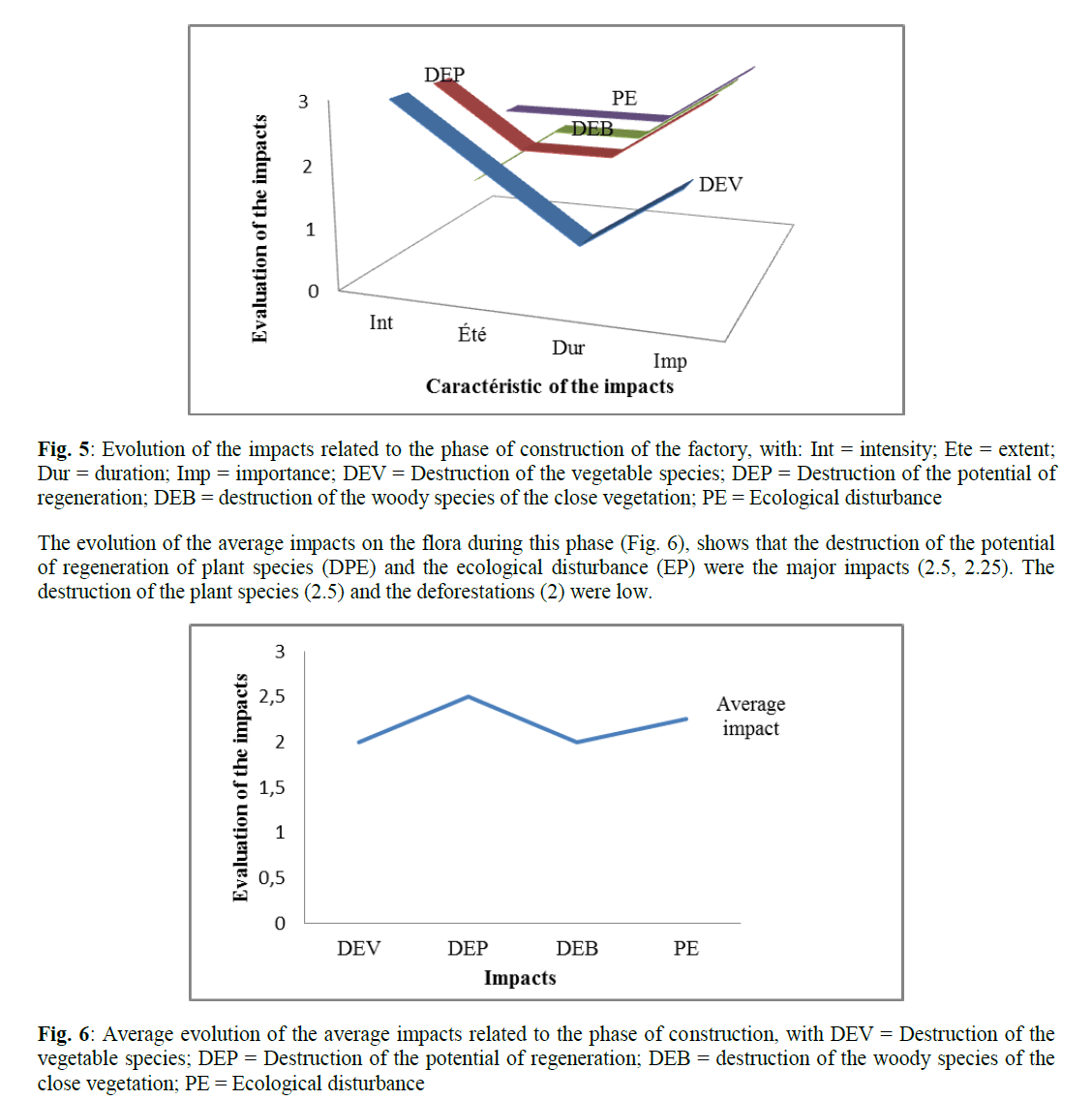 |
| The evolution of the curves (Fig. 7) during the production shows the variation of the impacts on the vegetation, the flora of the site and on that of the contiguous vegetable formations. During this phase, the destruction of the plant species (DEV.) and the proliferation of herbaceous (PRO) were intense (3), were extended (3), were long (3) and important (3). The fragmentation and the impoverishment of the vegetation were intense (3), average extended (2), long (2) and important (3). The evolution of the average impacts on the flora during this phase (Fig. 8), watch that the proliferation of the weeds (PRO) and the destruction of the plant species (DEV.) were the major impacts (3). The fragmentation and the impoverishment of the flora woody in cash (FAA) were less (2.75) with this phase. |
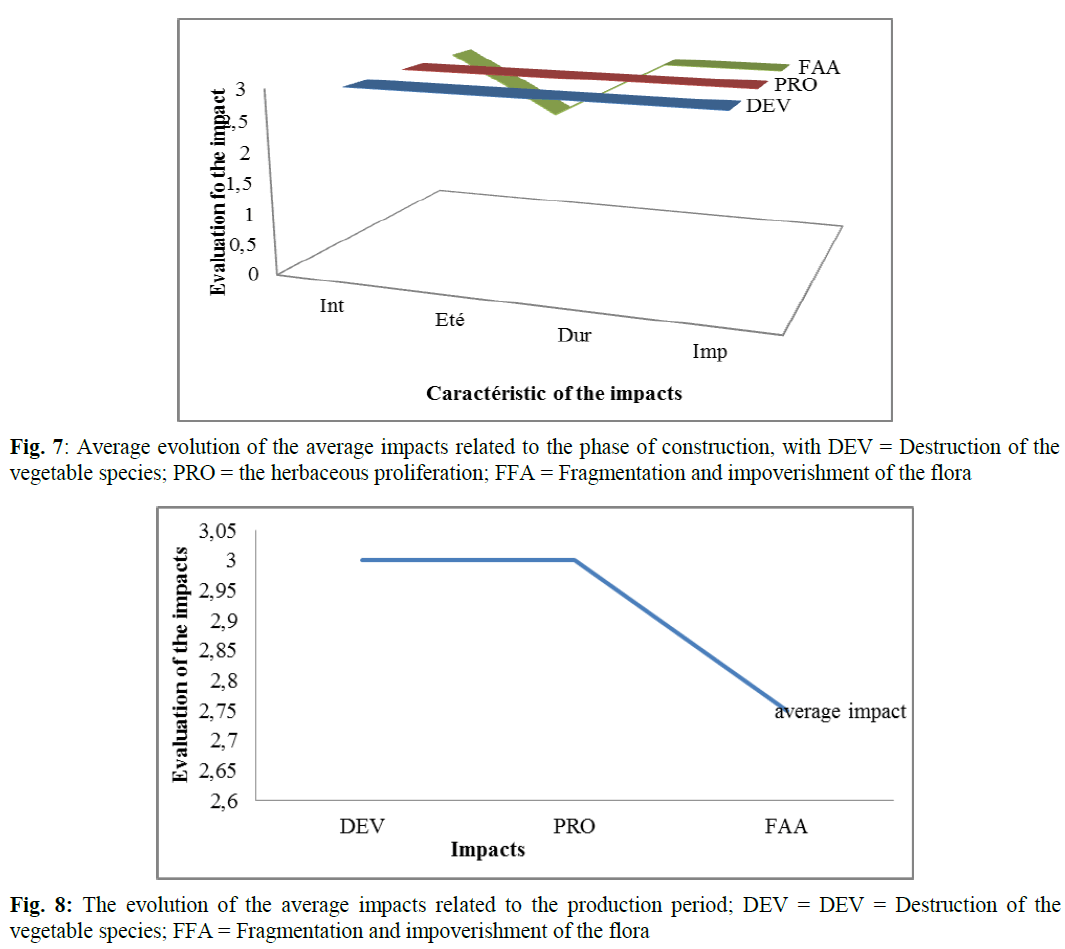 |
| The evolution of the curves (Fig. 9), at the end of the project shows the variation of the impacts related to the closing of the project on the vegetation, the flora of the site and on that of the contiguous vegetable formations. During this phase, the evolution of the aspect of the vegetation was fairly intense (2), was extended (2), long (3) and important (3). The evolution of specific diversity (EDS) was fairly intense (2), fairly wide (2), of long life (3) and average importance (2). Also, evolution of the average impacts on the flora during this phase (Fig. 10), watch that the evolution of the aspect of vegetation (PH) was the major impact (2.75). On the other hand, the evolution of specific diversity (EDS) was less perceptible (2, 25) at this phase. |
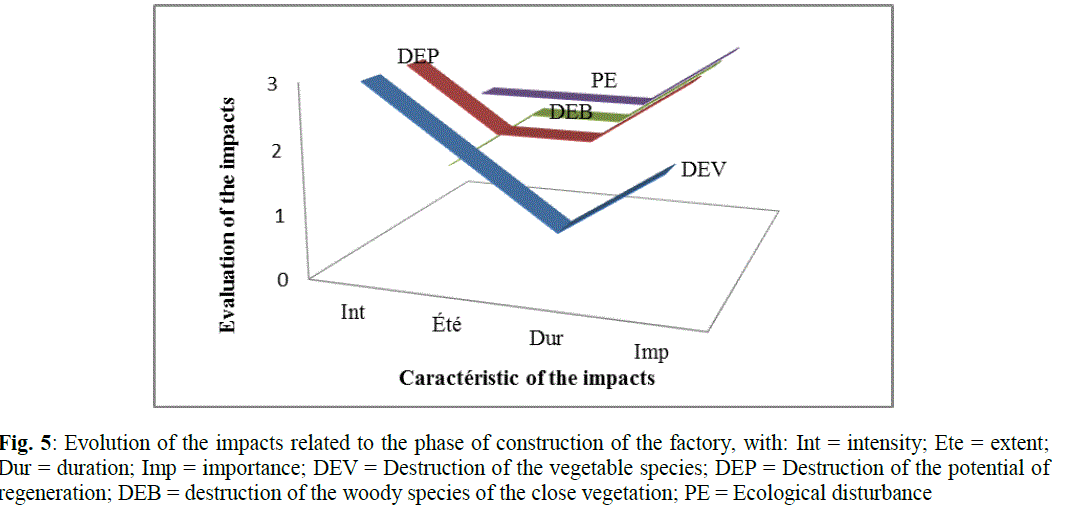 |
4-2- Discussion |
| The criteria of evaluation of the impacts are numerous. On these criteria it is necessary to add, the quantity and the quality of the flora, the potentialities of reconstitution and/or regeneration etc. On the basis of definite criteria the impacts were evaluated. However, this site shelters endemic species of the rain forest such as Heisteria parvifolia and Heremospatha macrocarpa which are endangered species. This site thus still abounds in the species which according to the ecological classification of Claude et al. [9], are in "K" group (large trees, more stable). But this site sheltered several crop years which contributed to reduce to a significant degree it biodiversity. |
4-2-1- Evolution of the indices of diversity |
| The analysis of the flora of the site showed that it was diversified little (H= 3.64) and fairly homogeneous (E = 0.55). The various activities undertaken in this zone were ecological sources of disturbances, and can be regarded as major disturbances of the ecosystems. Indeed, the site is submitted to intense frequentations. Also, numerous species are exploited in the flora of the site. The impacts related to the installation of the infrastructures of the factory, were caused by the machines motorized through scourings and compaction of the ground of the site, clearings of the ligneous family and the hiding of the seeds of certain woody species of the original flora. These causes have also involved ecological and biological disturbances (destruction of the ecosystems). |
4-2-2- Evolution of the environmental impacts |
| The environmental impacts are observed during the phases of exploration, construction and exploitation, like at the end of the project. During the phase of construction, the earthworks involved the destruction of the flora of the site and that of certain bordering vegetations of the site of the project. Some specimens of trees, shrubs, lianas and herbaceous were destroyed. The openings carried out in the flora contributed to increase to a significant degree the luminosity on the ground in these usually closed formations exposing thus the species of the underwoods very sensitive to excesses of light. The Epiphytes are found on the ground following the demolition of the large trees. All these movements involved an ecological imbalance within the vegetable formations concerned. During the production run, the extent of the disturbances was accentuated. The destruction became more important in the flora of the contiguous vegetations. The proliferation of herbaceous numerous heliophilous species is due to the exposure of the underwood to the too strong luminosities. Therefore, the capacity of these herbaceous at reproduction is the cause of fast colonization of the mediums degraded like it has been mentioned by Claude et al. [7]. In addition, the many frequentations of the workers in search of vegetable bodies for utility needs had an additional effect on the impacts; especially with regard to the destruction of vegetable numerous species. At the end of the project, the original vegetation knew a considerable loss as regards vegetable diversity. The canopy underwent profound changes and the aspect of the vegetation was modified. Numerous species endemic such as Hesteria parvifolia, rare, and with particular status disappeared from the zone. The rich and diversified vegetation vegetable in cash disappeared and left on the spot a sparse forest with some species appraisal such Eremospatha macrocarpa. The vegetation is from now on mainly made up the herbaceous ones. The degradation of the surrounding formations is related to the human pressure. On the whole, the zone lost its rich and diversified forest. The biological diversity regressed considerably under the pressures of anthropic origins. The characterization and the evaluation of the impacts on the flora of the site are supposed to bring a thorough lighting on the nature (intensity, extended and lasted) of the impacts. Thus, the intense impacts (EPD and DEV.) recorded with the phase of construction were caused by mechanical undergrowth cutting, soil scourings by the Bulldozer, the regular maintenance of site etc. The regular maintenance of the site which comprises demolitions and the clearing of certain woody species have intensely affected all the components of the flora sometimes compromising its total regeneration like it announced by Mitja and Puig [10] in forest zone and Yossi [11] in savanna zone . The building work involved ecological disturbances (EP) important. Indeed, these activities are at the bases of punctures recorded in the flora and the migration of the animals. During the exploitation the destruction of plant (DEV) and the proliferation of herbaceous (PRO), have been at the same time intense, long and important, were only the consequences of the sources activities of impacts started since the phase of construction; they are amongst other the regular maintenance of the site, the cutting in the flora and the regular frequentations of site etc. At the end of the project, the intensity of the evolution of the diversity of the flora is related to the stoppage of the works. This suspension of the activities is the cause of this renewal of diversity. The significant impacts during the prospection and construction (DPE and DEV.) were caused by the total destruction of the flora and the compaction of the ground at certain places by the mechanical machines. This beginning of the destruction involved many consequences in particular the deforestation and the impoverishment of the flora in woody species and forest fragmentation (FAA) and the proliferation of herbaceous (PRO). The estimate of the average impacts made it possible to release the major impacts with each phase of the project. Thus, the ecological disturbances, and the destruction of the potential of regeneration (DPE) and the disturbances ecological (EP) identified as major impacts during the construction are the consequences of the cumulated effects of several impacts. In the same way, the destruction of the plant species (DEV.) and the proliferation of herbaceous (PRO) identified as major impacts during the production are related on the persistence of work and the continuous maintenance of the site. The importance of the evolutions of floristic diversity and the aspect of many vegetation of the site at the end of the project is related to the stop of any activity on the site of the project. But this evolution is also related to the afforestation started at the beginning of this period. These woody species growth is slow like it was mentioned by Kouassi [1] and Kouadio et al. [12]. These impacts with significant effect on the short, means and long term are those which were identified like major impacts at the end of the project. |
CONCLUSION |
| If we consider the floristic parameters, the site of the factory is fairly rich and low diversified. This diversity was strongly influenced by the installation, and the execution of the project. Thus, the destruction of the potential of regeneration (DPE) and the disturbances ecological (EP) were identified like major impacts during construction. In the same way the destruction of the plant species (DEV.) and the proliferation of herbaceous (PRO) are those which were identified like major impacts during the production. At the end of the project, the evolution of diversity specific (EDS) and the evolution of the aspect of forest (PH) were more perceptible. However, of measurements of attenuation (afforestation containing local woody species) can strongly contribute to reduce the risks of ecological imbalances which could occur in the future. |
References |
|